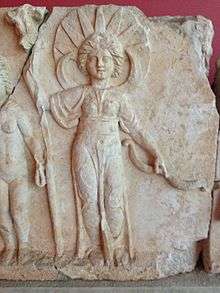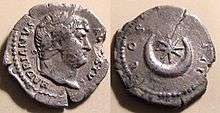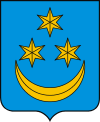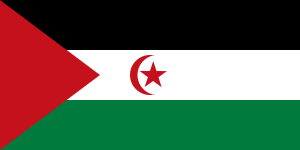Star and crescent

A star (or stars) and crescent featuring in some combination form the basis of symbols widely found across the ancient world, with examples attested from the Eastern Mediterranean, Persia and Central Asia.[1]
The symbol emerged into popular use during the 19th century as a modernistic national symbol for the Ottoman Empire during the Westernizing Tanzimat reforms. The Ottoman flag of 1844 with a white "ay-yıldız" (Turkish for "star-crescent") on a red background continues to be in use as the flag of the Republic of Turkey with minor modifications. Other states formerly part of the Ottoman Empire also used the symbol, including Libya (1951–1969 and after 2011), Tunisia (1956) and Algeria (1958). The same symbol was used in other national flags introduced during the 20th century, including the flags of Azerbaijan (1918), Pakistan (1947), Malaysia (1948), and Mauritania (1959).
During the 1950s to 1960s, the symbol was re-interpreted as the symbol of Islam or the Muslim community.[2] By the 1970s, this symbolism was embraced by movements of Arab nationalism or Islamism, such as the proposed Arab Islamic Republic (1974) and the American Nation of Islam (1973).[3]
Use in antiquity
Ancient Near East
The star and crescent appear, used in combination, in and around ancient Palestine. It has been associated with the Moabites (14th or early 13th – 6th century BC[4]), as the symbol or symbols appear on what are thought to be Moabite name seals.[5] Crescents appearing together with a star or stars are a common feature of Sumerian iconography, the crescent usually being associated with the moon god Sin (Nanna to the Sumerians) and the star (often identified as Venus) with Ishtar (Inanna to the Sumerians). However, in this context, there is a third element often seen, that being the sun disk of Shamash. Academic discussion of a star or stars together with crescents in Sumerian representations does not always clearly indicate if they appear in isolation (the "star and crescent" as such) or as part of a triad of symbols, "the three celestial emblems, the sun disk of Shamash (Utu to the Sumerians), the crescent of Sin (Nanna), and the star of Ishtar (Inanna to the Sumerians)"[6] or "the crescent of Sin (the moon god), the star of Ishtar and the ray of Shamash".[7] Nevertheless, later use of the star and crescent by the Parthians, and other Iranian dynasties is often traced to earlier use in Mesopotamia. As one scholar observed, "[t]he Parthian king Mithradates I conquered Mesopotamia around 147 BC, and Susa in about 140 BC A later Parthian king, Orodes II (58-38 BC), issued coins at Susa and elsewhere which display a star and crescent on the obverse. The succeeding ruler, Phraates IV (38-3/2 BC), minted coins showing either a star alone or a star with crescent moon. In representing the star and crescent on their coins the Parthians thus adopted traditional symbols used in Mesopotamia and Elam more than two millennia before their own arrival in those parts."[8] Along these lines, some scholars maintain that later use of the symbol arose from Babylonian mythology in which the juxtaposition of Sin (moon god, father of time) and Shamash (supreme ruling sun god, judge of heaven and earth) was a metaphor for the cosmic powers given to the Babylonian king to rule.[9]
Iran, Mithra and Mithradates

The star and crescent was also the emblem of Mithradates VI Eupator. "His royal emblem, an eight rayed star and the crescent moon, represented the dynasty's patron gods, Zeus Stratios, or Ahuramazda, and Men Pharmacou, a Persian form of the native moon goddess."[10] Other scholars have suggested that the star and crescent are more directly related to the cult of the god Mithra. Ustinova associates the star and crescent motif attested in a number of finds in the Bosporan Kingdom (which date from the 5th century BC to the 1st century AD) with the cult of Mithras, and indicates the star and the crescent together constituted the emblem of Pontus and its kings, asserting that it was introduced to the Bosporus by Mithradates and his successors, where it is attested on coins, locally produced jewelry and other objects. She suggests that this emblem indicates "the possibility of an earlier association of the Pontic dynasty with the cult of mounted Mithra. Mithra in fact must have been one of the most venerated gods of the Pontic Kingdom, since its rulers bore the theomorphic name of Mithradates ... although direct evidence for this cult is rather meager."[11] McGing also notes the association of the star and crescent with Mithradates VI, discussing its appearance on his coins, and its survival in the coins of the Bosporan Kingdom where "[t]he star and crescent appear on Pontic royal coins from the time of Mithradates III and seem to have had oriental significance as a dynastic badge of the Mithridatic family, or the arms of the country of Pontus."[12]
According to Erciyas (2005),
The significance of the star and crescent on royal coins has also been frequently debated. Many scholars have identified the star and the crescent as royal symbols of the Pontic kingdom. Their appearance on every royal issue suggests they were indeed important symbols, and the connection of this symbol to the royal family is definite. The nature of it, however, is still uncertain. Kleiner believed they were symbols of an indigenous god and had their origins in Persia. He associated the star and crescent with the god Men and saw them as representations of night and day (the star may be considered the sun here). Ritter, on the other hand, suggested that the star and crescent symbols derived from Perseus, just as the star symbol of the Macedonians did. […] Ma and Mithras are two other deities with whom the star and crescent symbol are associated. Olshausen believed that the star and crescent could be related to a syncretism of Pontic and Iranian iconography: the crescent for Men and the star for Ahura Mazda. Recently, Summerer has convincingly suggested that Men alone was the inspiration for the symbol on the royal coins of the Pontic kingdom.[13]
A combined star and crescent motif is commonly found on later coins minted by the Sassanids.[14] This has led some researchers to suggest that Muslims adopted the symbol in the context of its use by Sassanian rulers. After describing the crowns of a number of Sassanid kings, which featured a crescent, sphere and crescent, or star and crescent, H. Ayatollahi remarks, "Sasani coins remained in circulation in Moslem countries up to the end of the first century (Hijra). This detailed description of Sasani crowns was presented because the motifs mentioned, particularly the crescent and star gradually changed into Islamic symbols and have often appeared in the decorative patterns of various periods of Islamic art." This author asserts that "The flags of many Islamic countries bear crescents and stars and are proof of this Sasani innovation.".[15]
Hellenistic and Roman



By the late Hellenistic or early Roman period, the star and crescent motif had been associated to some degree with Byzantium. If any goddess had a connection with the walls in Constantinople, it was Hecate. Hecate had a cult in Byzantium from the time of its founding. Like Byzas in one legend, she had her origins in Thrace. For example, some Byzantine coins of the 1st century BC and later show the head of Artemis with bow and quiver, and feature a crescent with what appears to be a six-rayed star on the reverse. In 330 AD, Byzantium Emperor Constantin used this symbol while rededicating Constantinople to Virgin Mary.[16] According to accounts which vary in some of the details, in 340 BC the Byzantines and their allies the Athenians were under siege by the troops of Philip of Macedon. On a particularly dark and wet night Philip attempted a surprise attack but was thwarted by the appearance of a bright light in the sky. This light is occasionally described by subsequent interpreters as a meteor, sometimes as the moon, and some accounts also mention the barking of dogs. However, the original accounts mention only a light in the sky, without specifying the moon.[17] To commemorate the event the Byzantines erected a statue of Artemis (or Hecate) lampadephoros (light-bearer or bringer). This story survived in the works Hesychius of Miletus, who in all probability lived in the time of Justinian I. His works survive only in fragments preserved in Photius and the 10th century lexicographer Suidas. The tale is also related by Stephanus of Byzantium, and Eustathius.
Devotion to Hecate was especially favored by the Byzantines for her aid in having protected them from the incursions of Philip of Macedon. Her symbols were the crescent and star, and the walls of her city were her provenance.[18]
Later, under the Romans, cities in the empire often continued to issue their own coinage. "Of the many themes that were used on local coinage, celestial and astral symbols often appeared, mostly stars or crescent moons."[6] The wide variety of these issues, and the varying explanations for the significance of the star and crescent on Roman coinage precludes their discussion here. It is, however, apparent that by the time of the Romans, coins featuring a star or crescent in some combination were not at all rare.
Middle Ages and Renaissance
In the Middle Ages, the star and crescent combination was not associated with Islam, and does appear in Christian iconography.[19] [20]
The use of the crescent symbol (without the star) on Muslim flags is first seen by Europe during the Crusades. Flags showing crescents appear in depictions of flags from the 14th century, in the Libro de Conoscimiento and the Catalan Atlas.
In these early examples, the crescent mostly pointed upward. 14th-century Muslim flags with an upward-pointing crescent in a monocolour field included the flags of Gabes, Tlemcen (Tilimsi), Damas and Lucania, Cairo, Mahdia, Tunis and Buda.[21] Evidence of crescent use is also found in the 14th century blue ensign of Nubia/Dongola (documented by Angelino Dulcert in 1339) and yellow ensign of the Mamluks of Egypt.[22] Flags with crescents facing the fly are attested from the 17th century.

In the Late Middle Ages it became fashionable to show attributed arms for historical and legendary individuals. Virgil Solis in his Wappenbüchlein (1555) shows such fictitious coats of arms for the Three Magi; the coat of arms attributed to Balthasar as a yellow star and crescent on a blue field. Later in the 16th century, the Korenić-Neorić Armorial shows a white star and crescent on a red field as the coat of arms of Illyria.
Usage in the Mughal Empire
The Mughal Emperor Shah Jahan (r. 1628–1658) is known to have inlaid the Crescent and Star symbol upon his personal shield, and his son Aurangzeb (r. 1658–1707) is known to have used similar shields and flags containing an upward star and crescent symbol. The Nawab of the Carnatic in the first half of the 19th century also appears to have used flags with a star and crescent symbol.[23]
-

A miniature painting from the Padshahnama, depicting Mughal Emperor Shah Jahan (note: The upward Crescent and Star symbol, inlaid upon the imperial shield).
-

The finial upon the Taj Mahal is topped on the main spire with the combined spear and crescent representing the official military standard of the Mughal Emperor.
Use in the Ottoman Empire

It has been suggested that the star-and-crescent used in Ottoman flags of the 19th century had been adopted from the Byzantines. Franz Babinger (1992) suggests this possibility, noting that the crescent alone has a much older tradition also with Turkic tribes in the interior of Asia.[24] Parsons (2007) considers this unlikely, as the star and crescent was not a widespread motive in Byzantium at the time of the Ottoman conquest.[25]
Turkish historians tend to stress the antiquity of the crescent (not star-and-crescent) symbol among the early Turkic states in Asia.[26] In Turkish tradition, there is an Ottoman legend of a dream of the eponymous founder of the Ottoman house, Osman I, in which he is reported to have seen a moon rising from the breast of a Muslim judge whose daughter he sought to marry. "When full, it descended into his own breast. Then from his loins there sprang a tree, which as it grew came to cover the whole world with the shadow of its green and beautiful branches." Beneath it Osman saw the world spread out before him, surmounted by the crescent.[27]
Successor states of the Ottoman Empire
Besides the most prominent example of Turkey (see Flag of Turkey), a number of other Ottoman successor states adopted the design during the 20th century, including the Emirate of Cyrenaica and the Kingdom of Libya, Algeria, Tunisia, and the proposed Arab Islamic Republic.
Contemporary use
Today the flag is also used by Muslim-majority states which are not successor states of the Ottoman Empire.
Muslim-majority state flags
National flags (used by sovereign states) displaying the star-and-crescent symbol:
Flags with variant symbols, involving a crescent and several stars:
Muslim-majority state emblems
Other Muslim organizations or territories
Other flags with the symbol, used by communities, separatist and political movements, dependent territories, autonomous areas or partially recognized states:
-

Flag of Aceh
-

Flag of the Arab Maghreb Union
-

Flag of Muslim Bosnians
-

Flag of Grande Comore
-

Flag of Hatay State (1937-1938)
-

Flag of Hyderabad (princely state) (1724-1948)
-

Flag of Iraq Turkmen Front
-

Princely flag of Janjira
-

Flag of Kashmir
-
.svg.png)
Flag of the Kingdom of Egypt and the Republic of Egypt (1923 – 1958)
-

Flag for the Nation of Islam
-
Flag of Provisional Government of Western Thrace (1913)
-

Flag used by Tatarstan nationalists
Non Muslim-majority state flags
The People Nation street gangs have been known to use a star and crescent.[28] The Leliwa coat of arms, one of Poland's many coats-of-arms adopted by several families, used the star and crescent. One of the families that adopted it was the Tarnowski family, and its usage is reflected on the arms of several Polish and Ukrainian towns.
Non Muslim-majority state/territory emblems
-

Coat of arms of Zagreb, Croatia.
-

Coat of arms of Varnsdorf, Czech Republic.
-

Coat of arms of Grabow, Germany.
-
.svg.png)
Coat of arms of Halle an der Saale, Germany.
-

Coat of arms of Oelde, Germany.
-

Coat of arms of Schleswig, Germany.
-

Coat of arms of Drogheda, Ireland.
-
Alpha Theta Sigma, Philippines.
-

Coat of arms of Mińsk Mazowiecki, Poland.
-

Coat of arms of Przeworsk, Poland.
-

Coat of arms of Tarnobrzeg, Poland.
-

Coat of arms of Tarnów, Poland.
-

Coat of arms of Sintra, Portugal.
-

Flag of Székely Land, Romania.
-

Coat of arms of Ronneby, Sweden.
-

Coat of arms of Ödeshög, Sweden.
-

Coat of arms of Terebovl, Ukraine.
-

Coat of arms of Ternopil, Ukraine.
-

Flag of Portsmouth, England.
-
.svg.png)
Coat of arms of the Duke of Buccleuch, Scotland, United Kingdom.
-
.svg.png)
Coat of Arms of the Viscount of Arbuthnott, Scotland, United Kingdom.
References
- ↑ In the Near East and Eastern Mediterranean, see for example the 'Ur-Nammu stela' of ca. 2100-2200 BCE: "Over the king's head, at the top of the stela, is a very large star or radiant sun-disc, floating free within a crescent." Jeanny Vorys Canby, The "Ur-Nammu" Stela, University of Pennsylvania Museum of Archaeology, 2006, p18; In Central Asia and India see, for example, a coin issue of Chashtana (probably dating to the late first or early second century AD): "A rare type with crescent and star alone on the reverse is probably Chashtana's earliest issue, struck before he extended his power into Malwa." H.H. Dodwell (Ed.), The Cambridge Shorter History of India, Cambridge University Press, 1935, p83; early Mesopotamian and, much later, Sassanian examples of the 'star and crescent' motif are of course well known.
- ↑ The symbolism of the star and crescent in the flag of the Kingdom of Libya (1951–1969) was explained in an English language booklet, The Libyan Flag & The National Anthem, issued by the Ministry of Information and Guidance of the Kingdom of Libya (year unknown, cited after Jos Poels at FOTW, 1997) as follows: "The crescent is symbolic of the beginning of the lunar month according to the Muslim calendar. It brings back to our minds the story of Hijra (migration) of our Prophet Mohammed from his home in order to spread Islam and teach the principles of right and virtue. The Star represents our smiling hope, the beauty of aim and object and the light of our belief in God, in our country, its dignity and honour which illuminate our way and puts an end to darkness."
- ↑ Edward E. Curtis, Black Muslim religion in the Nation of Islam, 1960–1975 (2006), p. 157.
- ↑ A.H. van Zyl, The Moabites, Brill, 1960, pp 111–112, 157–158
- ↑ Othmar Keel, Christoph Uehlinger, Gods, Goddesses, and Images of God in Ancient Israel, Fortress Press, 1998, p322
- ↑ Irving L. Finkel, Markham J. Geller, Sumerian Gods and Their Representations, Styx, 1997, p71
- ↑ André Parrot, Sumer: The Dawn of Art, Golden Press, 1961
- ↑ John Hansman, "The great gods of Elymais" in Acta Iranica, Encyclopédie Permanente Des Etudes Iraniennes, v.X, Papers in Honor of Professor Mary Boyce, Brill Archive, 1985, pp 229–232
- ↑ Michael R. Molnar, The Star of Bethlehem, Rutgers University Press, 1999, p78
- ↑ Andrew G. Traver, From Polis to Empire—The Ancient World c. 800 B.C.–A.D. 450, Greenwood Publishing Group, 2002, p257
- ↑ Yulia Ustinova, The Supreme Gods of the Bosporan Kingdom, Brill, 1998, pp 270–274
- ↑ B.C. McGing, The Foreign Policy of Mithradates VI Eupator, King of Pontus, Brill, 1986, p 97
- ↑ Deniz Burcu Erciyas, "Wealth, Aristocracy, and Royal Propaganda Under The Hellenistic Kingdom of The Mithradatids in The Central Black Sea Region in Turkey", Colloquia Pontica Vol.12, Brill, 2005, p 131
- ↑ "The star and crescent are common Persian symbols, being a regular feature of the borders of Sassanian dirhems." Philip Grierson, Byzantine Coins, Taylor & Francis, 1982, p118
- ↑ Habibollah Ayatollahi (trans. Shermin Haghshenās), The Book of Iran: The History of Iranian Art, Alhoda UK, 2003, pp 155–157
- ↑ Cathedral of Learning, University of Pittsburgh, the Turkish Nationality Room Dedication Book, March 4, 2012, p 3
- ↑ "In 340 B.C., however, the Byzantines, with the aid of the Athenians, withstood a siege successfully, an occurrence the more remarkable as they were attacked by the greatest general of the age, Philip of Macedon. In the course of this beleaguerment, it is related, on a certain wet and moonless night the enemy attempted a surprise, but were foiled by reason of a bright light which, appearing suddenly in the heavens, startled all the dogs in the town and thus roused the garrison to a sense of their danger. To commemorate this timely phenomenon, which was attributed to Hecate, they erected a public statue to that goddess [...]" William Gordon Holmes, The Age of Justinian and Theodora, 2003 p 5-6; "If any goddess had a connection with the walls in Constantinople, it was Hecate. Hecate had a cult in Byzantium from the time of its founding. Like Byzas in one legend, she had her origins in Thrace. Since Hecate was the guardian of "liminal places", in Byzantium small temples in her honor were placed close to the gates of the city. Hecate's importance to Byzantium was above all as deity of protection. When Philip of Macedon was about to attack the city, according to he legend she alerted the townspeople with her ever-present torches, and with her pack of dogs, which served as her constant companions. Her mythic qualities thenceforth forever entered the fabric of Byzantine history. A statue known as the 'Lampadephoros' was erected on the hill above the Bosphorous to commemorate Hecate's defensive aid." Vasiliki Limberis, Divine Heiress, Routledge, 1994, p 126-127
- ↑ Vasiliki Limberis, Divine Heiress, Routledge, 1994, p 15
- ↑ "The earliest church in the Morea to include a saint holding a shield marked by the crescent and star may be St. John Chrysostom, which has been dated on the basis of style to ca. 1300 [...]" Angeliki E. Laiou, Roy P. Mottahedeh, The Crusades From the Perspective of Byzantium and the Muslim World, Dumbarton Oaks, 2001, p 278
- ↑ "when we come to examine the history of the crescent as a badge of Muhammadanism, we are confronted by the fact that it was not employed by the Arabs or any of the first peoples who embraced the faith of the prophet"
The truth is that the crescent was not identified with Islam until after the appearance of the Osmanli Turks, whilst on the other hand there is the clearest evidence that in the time of the Crusades, and long before, the crescent and star were a regular badge of Byzantium and the Byzantine Emperors, some of whom placed it on their coins. William Ridgeway, "The Origin of the Turkish Crescent", in The Journal of the Royal Anthropological Institute of Great Britain and Ireland, Vol. 38 (Jul. - Dec. 1908), pp. 241-258 (p 241)
- ↑ Znamierowski Flags through the ages: A guide to the world of flags, banners, standards and ensigns, (2000) section 'the Muslim crescent', cited by Ivan Sache, FOTW, 11 March 2001
- ↑ "After king Nasr ad din had fled to Cairo in 1397 to beg assistance against his cousin, the King of Nubia is depicted with a yellow flag with a white crescent but also with a yellow shield with a white crescent. At the same time the yellow crescented flag waves over all the Mameluk Empire. The flag of the Sultan of Egypt is yellow with three white crescents. From this we may conclude that any autonomy of the Nubian king was over at the time. " http://www.hubert-herald.nl/SudanI.htm
- ↑ Aldo Ziggiotto, Vessillologia dell' India — Paese principesco e feudale (1998)
- ↑ "It seems possible, though not certain, that after the conquest Mehmed took over the crescent and star as an emblem of sovereignty from the Byzantines. The half-moon alone on a blood red flag, allegedly conferred on the Janissaries by Emir Orhan, was much older, as is demonstrated by numerous references to it dating from before 1453. But since these flags lack the star, which along with the half-moon is to be found on Sassanid and Byzantine municipal coins, it may be regarded as an innovation of Mehmed. It seems certain that in the interior of Asia tribes of Turkish nomads had been using the half-moon alone as an emblem for some time past, but it is equally certain that crescent and star together are attested only for a much later period. There is good reason to believe that old Turkish and Byzantine traditions were combined in the emblem of Ottoman and, much later, present-day Republican Turkish sovereignty." Franz Babinger (William C. Hickman Ed., Ralph Manheim Trans.), Mehmed the Conqueror and His Time, Princeton University Press, 1992, p 108
- ↑ John Denham Parsons, The Non-Christian Cross, BiblioBazaar, 2007, p 69:
Moreover, the question is what the symbol of Constantinople was at the time it was captured by the Turks. And an inspection of the coins issued by the Christian rulers of that city during the thousand years and more it was in their hands, will reveal to the enquirer that though the crescent with a cross within its horns appears occasionally upon the coins of the Emperors of the East, and in one or two instances we see a cross of four equal arms with each extremity piercing a crescent, it is doubtful if a single example of the so-called "star and crescent" symbol can be found upon them."
— John Denham Parsons, The Non-Christian Cross - ↑ "It is clear, however, that, whatever the origin, the crescent was used by Turkish states in various regions of Asia, and there is absolutely no reason to claim that it passed to the Ottomans from Byzantium" Mehmet Fuat Köprülü, Gary Leiser (Trans.), Some Observations On The Influence Of Byzantine Institutions On Ottoman institutions, Türk Tarih Kurumu, 1999, p 118
- ↑ Lord Kinross, The Ottoman Centuries: The Rise and Fall of the Turkish Empire, Morrow Quill Paperbacks, 1977, pp 23-24.
- ↑ Florida Department of Corrections. "People and Folk Nation Sets - Gang and Security Threat Group Awareness". Dc.state.fl.us. Retrieved 2011-04-16.
External links
| Wikimedia Commons has media related to Star and crescent. |
| Look up ☪ in Wiktionary, the free dictionary. |
- Charles Boutell. "Device of Star (or Sun) and Crescent". In: The Gentleman's Magazine, Volume XXXVI (New Series). London: John Nicols & Son, London, 1851, pp. 514–515. http://books.google.com/books/pdf/The_Gentleman_s_Magazine.pdf?id=ffMMN_clKR4C&output=pdf&sig=0SnjgHBVzek_Y7Hk4Ing5nJyH6I
























.svg.png)

_Islands.svg.png)












.svg.png)